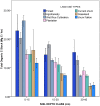Active and passive soil organic carbon pools as affected by different land use types in Mizoram, Northeast India
- PMID: 31361769
- PMCID: PMC6667142
- DOI: 10.1371/journal.pone.0219969
Active and passive soil organic carbon pools as affected by different land use types in Mizoram, Northeast India
Abstract
Soil organic carbon plays an important role in the stability and fertility of soil and is influenced by different management practice. We quantified active and passive carbon pools from total soil organic carbon (TOC) in seven different land use systems of northeast India. TOC was highest (2.75%) in natural forest and lowest in grassland (1.31%) and it decreased with increasing depth in different pools of lability. Very Labile Carbon (VLC) fraction ranged from 36.11 to 42.74% of TOC across different land use system. Active carbon (AC) pool was highest in Wet Rice Cultivation (61.64%) and lowest (58.71%) in natural forest. Higher AC pools (VLC and less labile) in most land use systems barring natural forests suggest that the land use systems in the region are vulnerable to land use change and must adopt suitable management practice to harness carbon sequestration.
Conflict of interest statement
The authors have declared that no competing interests exist.
Figures





Similar articles
-
Long-term effect of rice-based cropping systems on pools of soil organic carbon in farmer's field in hilly agroecosystem of Manipur, India.Environ Monit Assess. 2020 Mar 4;192(4):209. doi: 10.1007/s10661-020-8165-x. Environ Monit Assess. 2020. PMID: 32128626
-
Effect of land use and soil depth on the distribution of phyto-available nutrients and SOC pools of Vertisols in Central India.Environ Monit Assess. 2023 Nov 2;195(12):1405. doi: 10.1007/s10661-023-12032-9. Environ Monit Assess. 2023. PMID: 37917226
-
Studying the relationship between total organic carbon and soil carbon pools under different land management systems of Garo hills, Meghalaya.J Environ Manage. 2020 Mar 1;257:110002. doi: 10.1016/j.jenvman.2019.110002. Epub 2019 Dec 20. J Environ Manage. 2020. PMID: 31868650
-
Variations in soil organic carbon decompositions of different land use patterns on the tableland of Loess Plateau.Environ Sci Pollut Res Int. 2020 Feb;27(4):4337-4352. doi: 10.1007/s11356-019-07099-2. Epub 2019 Dec 12. Environ Sci Pollut Res Int. 2020. PMID: 31832943
-
Grassland management impacts on soil carbon stocks: a new synthesis.Ecol Appl. 2017 Mar;27(2):662-668. doi: 10.1002/eap.1473. Ecol Appl. 2017. PMID: 27875004 Review.
Cited by
-
Responses of soil labile organic carbon stocks and the carbon pool management index to different vegetation restoration types in the Danxia landform region of southwest China.PLoS One. 2025 Feb 25;20(2):e0318195. doi: 10.1371/journal.pone.0318195. eCollection 2025. PLoS One. 2025. PMID: 39999182 Free PMC article.
-
Partial substitution of chemical fertilizer with organic fertilizer: a promising circular economy approach for improvement soil physical and chemical properties and sustainable crop yields.Front Plant Sci. 2025 May 20;16:1565081. doi: 10.3389/fpls.2025.1565081. eCollection 2025. Front Plant Sci. 2025. PMID: 40464015 Free PMC article.
-
Soil organic carbon pools and carbon management index under different land use systems in North western Himalayas.PeerJ. 2023 Jun 6;11:e15266. doi: 10.7717/peerj.15266. eCollection 2023. PeerJ. 2023. PMID: 37304860 Free PMC article.
-
Remote Sensing of Depth-Induced Variations in Soil Organic Carbon Stocks Distribution Within Different Vegetated Landscapes.Catena (Amst). 2024 Aug;243:108216. doi: 10.1016/j.catena.2024.108216. Catena (Amst). 2024. PMID: 39021895 Free PMC article.
-
Dynamics of soil organic carbon of jhum agriculture land-use system in the heterogeneous hill of Arunachal Pradesh, India.Sci Rep. 2023 Jul 27;13(1):12156. doi: 10.1038/s41598-023-38421-1. Sci Rep. 2023. PMID: 37500678 Free PMC article.
References
-
- Krischbaum MUF. Will changes in soil organic carbon act as a positive or negative feed-back on global warming? Biogeochemistry 2000; 48: 21–51.
-
- Batjes NH. Total carbon and nitrogen in the soils of the world. Eur J Soil Sci.1996; 47: 151–163.
-
- Belay-Tedla A, Zhou X, Su B, Wan S, Luo Y. Labile, recalcitrant, and microbial carbon and nitrogen pools of a tallgrass prairie soil in the US Great Plains subjected to experimental warming and clipping. Soil Biol Biochem. 2009; 41, 110–116.
-
- Poeplau C, Don A. Sensitivity of soil organic carbon stocks and fractions to different land-use changes across Europe. Geoderma 2013; 192, 189–201.
Publication types
MeSH terms
Substances
LinkOut - more resources
Full Text Sources

